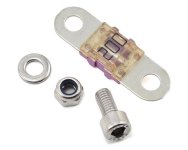Most BMS don't really have that protection or have it and it's light years from working properly.
If I don't have a fuse and touch the positive and negative together, when it goes bang and blows the tips of the wires, how much current is flowing there?
and how exactly their protection works?
I've had a friend crash his bike, the motor cable twisted, phases were shorted instantly and the motor blew a phase, controller went bang and the bms of his battery had his fets explode.
It was a 72V 40Ah Pack with a 150A BMS.
Now I figure that if it shorts permanently from the internals of the controller that the BMS will see an over current and should just cut power using the fets, so why did it blow?
Would like to know what is the most common scenario a fuse on the main + of the battery would protect from.
Plus, when I was researching fuses I found out that most use 12V fuses since they are the most common for high currents but the thing is that it seems like a fire hazard when you are dealing with around 80V most of the times with our high powered systems and that means that when using a 12V fuse with an 80V system that it's going to arch when it blows and create a fire.
Any ideas how to solve that?
If I don't have a fuse and touch the positive and negative together, when it goes bang and blows the tips of the wires, how much current is flowing there?
and how exactly their protection works?
I've had a friend crash his bike, the motor cable twisted, phases were shorted instantly and the motor blew a phase, controller went bang and the bms of his battery had his fets explode.
It was a 72V 40Ah Pack with a 150A BMS.
Now I figure that if it shorts permanently from the internals of the controller that the BMS will see an over current and should just cut power using the fets, so why did it blow?
Would like to know what is the most common scenario a fuse on the main + of the battery would protect from.
Plus, when I was researching fuses I found out that most use 12V fuses since they are the most common for high currents but the thing is that it seems like a fire hazard when you are dealing with around 80V most of the times with our high powered systems and that means that when using a 12V fuse with an 80V system that it's going to arch when it blows and create a fire.
Any ideas how to solve that?


